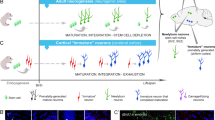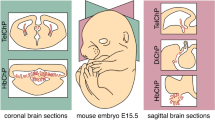Summary
The development of the neocortex has previously been extensively studied in carnivores (cat and ferret), rodents (rat and mouse) and primates (monkey and human). In these species, it has been shown that the initial population of cells migrating from the ventricular zone forms the primordial plexiform layer. This is subsequently split into marginal zone and subplate zone by the insertion of later-migrating cells into the primordial plexiform layer, to form the cortical plate proper. Many of the cells derived from the split primordial plexiform layer are transient. The neurons of the subplate zone are found in the deeper part of layer VI, and white matter deep to layer VI in the more mature cortex; most of these neurons disappear by adulthood. [3H]-thymidine labelling in the present study has shown a similar pattern of neocortical development in Artiodactyla (sheep). In addition it has been shown that the previously described staining of subplate and cortical plate cells for the fetal protein fetuin indicates that fetuin is a useful marker for a proportion of this transient population of neurons and defines its extent in neocortical development more clearly. Dividing cells were labelled by a single intra-amniotic injection of [3H]-thymidine at E26 to E35 (birth is at E150). The brains were subsequently examined at E40 or E80 for [3H]-thymidine labelling and fetuin staining by a combination of autoradiography and immunocytochemistry. The earliest generated neocortical cells detected in this study (E26) were found in two layers by E40, the outer marginal zone and inner subplate zone. Neurons of the marginal zone were generated up to E28; those of the early subplate zone were generated up to E31. The cortical plate proper was generated by cells “born” on E32 and later. This sequence is similar to that described in other species, especially the cat. A proportion of the early-generated neurons in the marginal zone, subplate zone and early cortical plate stained for fetuin. By E80 these earliest-generated, fetuin-positive cells were found in the white matter deep to the forming neocortical layers and in layer VI. In adult brains no fetuin-positive neurons could be identified in the neocortex, and neurons had almost entirely disappeared from the white matter. The fetal glycoprotein fetuin seems to be specifically associated with a population of cells that has the same developmental history as the transient marginal zone and subplate neurons described in other species. However, the distribution of fetuin-containing neurons is more extensive and includes some of the neurons within the cortical plate itself. Thus in addition to being a marker for a proportion of the transient marginal zone and subplate cells, the presence of fetuin in subplate and cortical plate neurons, given the “trophic” properties attributed to fetuin, may indicate its involvement in early stages of synaptogenesis and connectivity in the developing neocortex.
Similar content being viewed by others
References
Abdullah M, Crovell JA, Tres LL, Kirszenbaum AL (1986) Fetuin: a serum component associated with rat sertoli and spermatogenic cells in co-culture. J Cell Physiol 127:463–472
Allendoerfer KL, Shelton DL, Shooter EM, Shatz CJ (1990) Nerve growth factor receptor immunoreactivity is transiently associated with the subplate neurons of the mammalian cerebral cortex. Proc Natl Acad Sci USA 87:187–190
Bergmann FH, Levine L, Spiro RG (1962) Fetuin: immunochemistry and quantitative estimation in serum. Biochem Biophys Acta 58:41–51
Brown WM, Reynolds ML (1988) An autoradiographic study to determine the origin of α2HS-positive cells in the developing forebrain of the rat. J Physiol 400:65P
Brown WM, Dziegielewska KM, Saunders NR, Christie DL, Nawratil P, Müller-Esterl W (1992a) The nucleotide and deduced amino acid structures of sheep and pig fetuin. Eur J Biochem 205:321–331
Brown WM, Møllgård K, Saunders NR, Dziegielewska KM (1992b) Fetuin an old friend revisited. Bioessays (in press)
Cavanagh ME, Møllgård K (1985) An immunocytochemical study of the distribution of some plasma proteins within the developing forebrain of the pig with special reference to the neocortex. Dev Brain Res 17:183–194
Cavanagh ME, Parnavelas JG (1990) Development of neuropeptide Y (NPY) immunoreactive neurons in the rat occipital cortex: a combined immunohistochemical-autoradiographic study. J Comp Neurol 297:553–563
Chun JJM, Shatz CJ (1989) Interstitial cells of the adult neocortical white matter are the remnant of the early generated subplate neuron population. J Comp Neurol 282:555–569
Dziegielewska KM, Saunders NR (1988) The development of the blood-brain barrier: proteins in fetal and neonatal CSF, their nature and origins. In: Meisami E, Timiras PS (eds) Handbook of human growth and biological development, vol I Part A, CRC Press, Boca Raton, pp 169–191
Dziegielewska KM, Saunders NR (1991) The internal environment of the developing brain. In: Mednick SA, Cannon TD, Barr CE, La Fosse JM (ed) Fetal neural development and adult schizophrenia. NATO Advanced Research Workshop, Plenum Press, New York, pp 1–28
Dziegielewska KM, Evans CAN, Fossan G, Lorscheider FL, Malinowska DH, Møllgård K, Reynolds ML, Saunders NR, Wilkinson S (1980) Proteins in cerebrospinal fluid and plasma of fetal sheep during development. J Physiol 300:441–455
Dziegielewska KM, Møllgård K, Reynolds ML, Saunders NR (1987) A fetuin-related glycoprotein (α2HS) in human embryonic and fetal development. Cell Tissue Res 248:33–41
Dziegielewska KM, Brown WM, Casey S-J, Christie DL, Foreman RC, Hill R, Saunders NR (1990) The complete cDNA and amino acid sequence of bovine fetuin. J Biol Chem 265:4354–4357
Dziegielewska KM, Møllgård K, Saunders NR, Reader M (1992) Fetuin synthesis in cells of the immature neocortex. Submitted to J Neurocytol
Fisher DA, Lam RW (1974) Thyroid hormone binding by bovine and ovine fetuin. Endocrinology 94:49–54
Ghosh A, Antonini A, McConnell SK, Shatz CJ (1990) Requirements for subplate neurons in the formation of thalamocortical connections. Nature 347:179–181
Grinspan JB, Stern JL, Pustilnik SM, Pleasure D (1990) Cerebral white matter contains PDGF-responsive precursors to O2A cells. J Neurosci 10:1866–1873
Jacobson M (1991) Developmental neurobiology. 3rd edn. Plenum Press, New York
Jones SE, Dziegielewska KM, Saunders NR, Christie DL, Sveiras-Diaz J, Szelke M (1988) Early cortical plate specific glycoprotein in a marsupial species belongs to the same family as fetuin and α2HS glycoprotein. FEBS Letts 236:411–414
Jones SE, Christie DL, Dziegielewska KM, Hinds LA, Saunders NR (1991) Developmental profile of a fetuin-like glycoprotein in neocortex, cerebrospinal fluid and plasma of post-natal tarnmar wallaby (Macropus eugenii). Anat Embryol 183:313–320
Knox P, Griffiths S, Whately JG (1979) Fetal calf serum and the adhesion of cells in culture. Biochem Soc Trans 7:1011–1012
Kostavic I, Rakic P (1980) Cytology and time of origin of interstitial neurons in the white matter in infant and adult human and monkey telencephalon. J Neurocytol 9:219–242
Kostavic I, Rakic P (1990) Developmental history of the transient subplate zone in the visual and somatosensory cortex of the macaque monkey and human brain. J Comp Neurol 297:441–470
Lee C-C, Bowman BJ, Yang F (1987) Human α2HS glycoprotein: the A and B chains with a connecting sequence are encoded by a single mRNA transcript. Proc Natl Acad Sci USA 84:4403–4407
Libby P, Raines EW, Cuillinane PM, Ross R (1985) Analysis of the mitogenic effect of fetuin preparations on arterial smooth muscle cells: The role of contaminant platelet-derived growth factor. J Cell Physiol 125:357–366
Luskin MB, Shatz CJ (1985a) Studies of the earliest generated cells of the cat's visual cortex: cogeneration of subplate and marginal zones. J Neurosci 5:1062–1075
Luskin MB, Shatz CJ (1985b) Neurogenesis of the cat's primary visual cortex. J Comp Neurol 242:611–631
Marin-Padilla M (1988) Early ontogenesis of the human cerebral cortex. In: Peters A, Jones EG (eds) Cerebral cortex, vol 7. Plenum Press, New York, pp 1–34
McConnell SK (1989) The determination of neuronal fate in the cerebral cortex. TINS 12:342–349
Møllgård K, Reynolds ML, Jacobsen M, Dziegielewska KM, Saunders NR (1984) Differential immunocytochemical staining for fetuin and transferrin in the developing cortical plate. J Neurocytol 13:497–502
Puck TT, Waldren A, Jones C (1968) Mammalian cell growth proteins 1. Growth stimulation by fetuin. Proc Natl Acad Sci 59:192–199
Reader MR, Matthews N, Dziegielewska KM (1992) Synthesis of the plasma protein fetuin in the fetal sheep brain, as demonstrated by in situ hybridization. J Physiol 446:605P
Reynolds ML, Møllgård K (1985) The distribution of plasma proteins in the neocortex and early allocortex of the developing sheep brain. Anat Embryol 171:41–60
Reynolds ML, Cavanagh ME, Dziegielewska KM, Hinds LA, Saunders NR, Tyndale-Biscoe CH (1985) Postnatal development of the telencephalon of the tammar wallaby (Macropus eugenii): an accessible model of neocortical differentiation. Anat Embryol 173:81–94
Reynolds ML, Sarantis MEP, Lorscheider FL, Saunders NR (1987) Fetuin as a marker of cortical plate cells in the fetal cow neocortex: a comparison of the distribution of fetuin, α2HS glycoprotein, α-fetoprotein and albumin during early development. Anat Embryol 175:355–363
Rizzino A, Shermann MI (1979) Development and differentiation of mouse blastocysts in serum-free medium. Exp Cell Res 121:221–233
Sarantis MEP, Saunders NR (1986) An immunocytochemical demonstration of α2HS glycoprotein in the developing neocortex of the rat. Neurosci Lett 65:346–350
Saunders NR (1984) Plasma proteins and fetal brain development. In: Duprat AM, Kato AC, Weber M (eds) The roll of cell interactions in early neurogenesis. NATO Advanced Study Institute, Plenum Press, New York, pp 191–199
Saunders NR (1991) The development of the blood-brain barrier to macromolecules. In: Segal MB (ed) The fluids and barriers of the eye and brain. Macmillan, Basingstoke, pp 129–155
Saunders NR (1992) Ontogenetic development of brain barrier mechanisms. In: Bradbury MWB (ed) Physiology and pharmacology of the blood brain-barrier. Handbook of Experimental Pharmacology, Springer, Berlin Heidelberg New York, pp 327–369 (in press)
Shatz CJ, Chun JJM, Luskin MB (1988) The role of the subplate in the development of the mammalian telencephalon. In: Peters A, Jones EG (eds) Cerebral cortex, vol 7. Plenum Press, New York, pp 35–58
Sternberger LA (1979) Immunocytochemistry, 2nd edn. Wiley, New York, pp 89–92
Thompson RJ, Day INM (1988) Protein gene product (PGP) 9.5 — A new neuronal and neuronendocrine marker. In: Marnagos PJ, Cambell I, Cohen RM (eds) Neuronal and glial proteins: structure, function and clinical application. New Biological Research vol 2. California Academic Press, pp 209–228
Wahle P, Meyer G (1989) Early postnatal development of vasoactive intestinal polypeptide and peptide histidine isoleucine-immunoreactive structures in cat visual cortex. J Comp Neurol 282:215–248
Woo TU, Beale JM, Findlay BL (1991) Dual fate of subplate neurons in a rodent. Cerebral cortex 1:433–443
Yoshioka Y, Geijyo F, Marti T, Rickli E, Burgi W, Offner GD, Troxler, RF, Schmid K (1986) The complete amino acid sequence of the A chain of human plasma α2HS glycoprotein. J Biol Chem 261:1665–1676
Author information
Authors and Affiliations
Rights and permissions
About this article
Cite this article
Saunders, N.R., Habgood, M.D., Ward, R.A. et al. Origin and fate of fetuin-containing neurons in the developing neocortex of the fetal sheep. Anat Embryol 186, 477–486 (1992). https://doi.org/10.1007/BF00185461
Accepted:
Issue Date:
DOI: https://doi.org/10.1007/BF00185461




